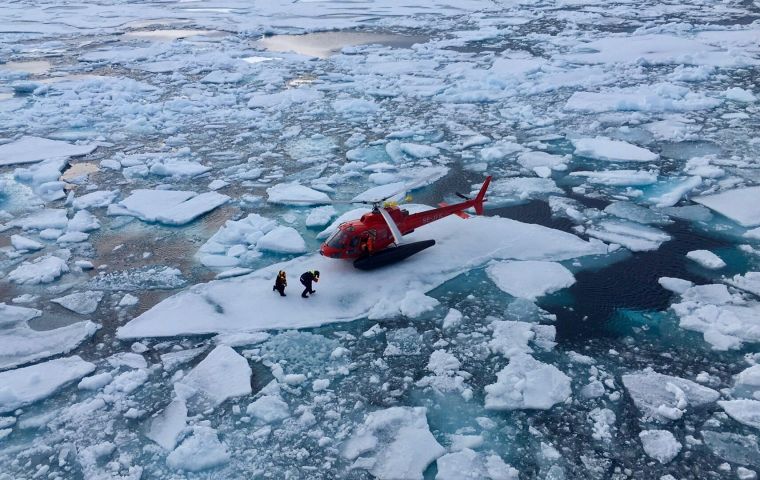MercoPress. South Atlantic News Agency
Arctic buoy with yearlong Beluga recordings salvaged by Swedish icebreaker
 “We were watching it drift away via satellite and it happened to drift past the Oden. It's great, amazing luck,” said Josh Jones from the Scripps Institutio
“We were watching it drift away via satellite and it happened to drift past the Oden. It's great, amazing luck,” said Josh Jones from the Scripps Institutio A year-long recording of the high-pitched clicks made by Beluga whales has been salvaged from the Arctic after the crew of a Swedish icebreaker chanced upon a research buoy adrift in hazardous pack ice.
A team tracking the device from California said they had almost given it up for lost when a “miracle” run of events allowed the vessel, the Oden, to stage an impromptu rescue while navigating through a channel in the far north of Canada.
“We were watching it drift away via satellite and it happened to drift past the Oden. It's great, amazing luck,” said Josh Jones, a graduate student researcher at the Scripps Institution of Oceanography in San Diego.
“Because it was stuck in heavy pack ice, it would have been only a matter of time before it would have been torn apart,” Jones remarked.
Scripps began deploying the buoy for year-long stints on the seabed in the Barrow Strait in the Canadian Arctic in 2013, aiming to use the sounds it registered to better understand the impact of climate change on the region's marine life.
The buoy would record ambient ocean noises, from the whir of passing ships' propellers or the vibrations of distant offshore oil drilling, to the high-pitched clicks of Beluga whales. The sounds - inaudible to humans - have earned the gregarious species the nickname “canaries of the sea.”
The eerie music of narwhals, known for their long “tusks”, and the sounds made by bowhead whales and bearded seals were also captured by the sensitive underwater equipment.
But two consecutive summers of heavy pack ice have prevented Jones and Randy Nungaq, a resident of Resolute Bay, from conducting their annual boat trip to maintain the buoy since 2017. The instrument only resurfaced in mid-July when a passing iceberg appears to have dragged it up from the seafloor.
Jones said he monitored the buoy as it drifted loose for about 10 days, fearing all the while that massive ice sheets would crush the device like a “trash compactor.”
It was pure chance that the Oden was passing nearby, carrying U.S. and Canadian scientists on a 2,000-nautical mile voyage through the Northwest Passage to raise awareness of the risks fast-melting sea ice pose to Earth's climate.
The Oden, operated by the Swedish Polar Research Secretariat, scrambled a helicopter to pinpoint the buoy then used its reinforced prow to prise it from the ice on July 25.
“I think it's groundbreaking because it's basically mapping the passage of whales and other marine mammals through these really important passageways between the Pacific and the Atlantic,” said Brice Loose, the chief scientist for the Oden expedition, known as the Northwest Passage Project.
“So really more than the loss of the instrument, it's the loss of the data if we weren't able to recover this, and so that's why we're here,” said Loose, a professor at the Graduate School of Oceanography at the University of Rhode Island.
The Northwest Passage Project, which groups various academic institutions, has staged three live broadcasts from the Oden via social media and dozens of public events in the United States. The icebreaker cast off from Thule, Greenland on July 18 and has conducted a series of experiments with the help of students on board.




Top Comments
Disclaimer & comment rulesCommenting for this story is now closed.
If you have a Facebook account, become a fan and comment on our Facebook Page!